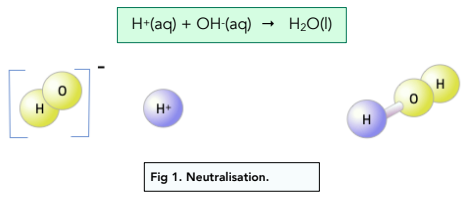Acids and Bases - Neutralisation Reactions (A-Level Chemistry)
Neutralisation Reactions
Neutralisation Reactions
Neutralisation
When acids and bases react, protons are transferred from the acid to the base to produce a salt and water.
The ionic equation for the reaction between any strong alkali and strong acid is:

If the proton concentration equals the concentration of hydroxide ions, all protons and all hydroxide ions in the solution will react to form water so that at the resulting solution is neutral.
Enthalpy Change
- Neutralisation reactions are associated with an enthalpy change. The enthalpy change associated with a neutralisation reaction, where one mole of water is produced from the reaction under standard conditions between an acid and a base, is known as enthalpy change of neutralisation.
- The standard enthalpy of neutralisation for weak acids and bases varies. Weak acids and bases only dissociate partially in solution. When the H+ or OH- ions get used up as part of a neutralisation reaction, the position of equilibrium shifts to the right so that more acid/base molecules dissociate. As a result the enthalpy change of neutralisation of weak acids and bases includes both the enthalpy change associated with the reaction between H+ and OH- ions and the enthalpy change associated with the dissociation, which varies greatly between acids/bases.
- The standard enthalpy of neutralisation for strong acids and bases stays fairly the same. As strong acids and bases dissociate fully in solution, no further dissociation takes place when they undergo a neutralisation reaction. Therefore, the enthalpy change of neutralisation for strong acids and bases consists only of the enthalpy change associated with the reaction between H+ and OH- , which is always the same.
Other Reactions with Acids
Acids react with metals to give a metal salt and hydrogen gas.

Acids react with metal carbonates to give a metal salt, carbon dioxide and water.

Reactions with strong acids will be faster, more vigorous and more exothermic than reactions with weak acids.
A Neutralisation Reaction is a chemical reaction between an acid and a base to form a salt and water. The reaction results in a neutral solution, meaning that the concentration of hydrogen ions (H+) and hydroxide ions (OH-) is equal, leading to a pH of 7.
During a Neutralisation Reaction, the hydrogen ions (H+) from the acid react with the hydroxide ions (OH-) from the base to form water. At the same time, the remaining positive and negative ions from the acid and base combine to form a salt.
Acids and Bases neutralise each other because they are complementary in nature. Acids have a surplus of hydrogen ions (H+), while bases have a surplus of hydroxide ions (OH-). When an acid and base are mixed together, the hydrogen ions (H+) from the acid react with the hydroxide ions (OH-) from the base to form water, neutralising each other.
Yes, all Acids and Bases can be neutralised. However, the reaction between some pairs of acids and bases may be more exothermic or more vigorous than others. It is important to handle these reactions with caution, as they can release a significant amount of heat and cause splattering.
The Neutralisation Reaction plays a crucial role in A-Level Chemistry, as it is a fundamental concept in understanding the behaviour of acids and bases. It is also an important reaction in many real-life applications, such as in the neutralisation of stomach acid after ingesting antacids.
A balanced chemical equation for a Neutralisation Reaction can be written as: Acid + Base → Salt + Water. The chemical formulas for the acid, base, salt, and water can be inserted into the equation, depending on the specific reaction.
The type of salt formed in a Neutralisation Reaction can be determined by the nature of the acid and base used in the reaction. For example, if a strong acid reacts with a strong base, the salt formed will be neutral. If a strong acid reacts with a weak base, the salt formed will be acidic, while if a weak acid reacts with a strong base, the salt formed will be basic.





Still got a question? Leave a comment
Leave a comment